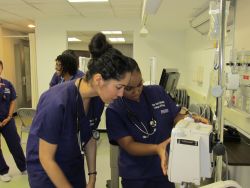State-of-the-Art Simulation: How Two NCIN Grantees Are Implementing and Improving Their Simulation Programs
There’s no substitute for clinical experience when you’re a nursing student, but there is an excellent complement to that experience: simulation. In the last decade, simulation labs and simulators (human patient simulators) have become increasingly popular and increasingly high tech. Several NCIN grantee institutions have invested in high-fidelity labs and simulators and are seeing great returns on these investments in their nursing students.
At both New York University (NYU) College of Nursing and the University of Miami School of Nursing and Health Studies, simulation is fully integrated into the nursing curriculum, and faculty receive regular training and education in using simulation to ensure that students derive the maximum benefit from this unique and important teaching tool. Both institutions also have large, state-of-the art simulation labs and strong commitments to ensuring that their students’ simulation experiences are as realistic as possible.
“Our expectation is that the students treat our simulator as a real patient,” said Kellie Bryant, DNP, WHNP, an associate clinical professor and the director of Simulation Learning at the College of Nursing. “Students are expected to behave in the same manner as if they were in their hospital based clinicals. When we first started using simulation, some students felt simulation wasn’t realistic. However through the years, students appreciate the value of simulation and their attitude has changed due to improvements in the way we conduct simulation and the increase in the medical technologies we incorporate into our simulations.
She also pointed out that one advantage of simulation is that it allows students the ability to provide a wider range of nursing care than they might be able to perform in the hospital setting. “Many hospitals have moved to an Electronic Medical Record system which many of our students are unable to access. This results in the inability for our students to document or even administer medications. With simulation, we are able to provide those opportunities they may not get in the hospital setting such as administering medication or charting on their patients,” said Bryant. “In a hospital setting, students are limited to caring for the patients who happen to be on the floor that day. In simulation, we can create a variety of scenarios and also ensure that every student gets an opportunity to provide care to a patient they will commonly care for as a graduate RN, such as stroke and heart failure.”
“Simulation provides an environment that allows us to learn and build confidence without putting patients at risk, or hindering the workflow of the nurse,” said Maritess Cabrera, an NYU nursing student and NCIN scholar. “The environment allows us to become comfortable with equipment and situations that may be foreign, therefore allowing us to be better prepared to provide quality care to our patients in the clinical setting."
Students also identify the opportunities to learn from one another and practice communication skills, as well as connect didactic learning to real-life situations as benefits of simulation.
NYU has six simulation rooms on three floors of the College of Nursing, and conducts 75 simulations a week. The University of Miami School of Nursing and Health Studies has four simulation labs—a total of 2,000 square feet— and 17 simulators. Both institutions use high-fidelity and mid-fidelity simulators depending on the nature of the simulations and have labs that are as realistic as possible, including all the monitors and equipment a nurse would encounter in a patient’s room or on a hospital unit. The high-fidelity simulators appear to breathe and speak, and have eyes that move. Each year, simulations at both institutions are updated to reflect new practices and to ensure that the courses are evidence-based.
“Simulation lets us help students master everything from simple concepts like therapeutic conversations to life-and-death situations in a safe environment,” said Susana Barroso, PhDc, RN, BSN, nurse specialist for simulation at the University of Miami School of Nursing and Health Studies. “And there are pre-simulation assignments, like researching certain conditions or diseases the students will be addressing during the simulation, and de-briefing sessions afterward to allow them to reflect on what just happened and what they learned. The de-briefing is crucial. That’s when students get a real chance to analyze what they did and why, and to think about what they should have done differently, if they made a mistake.”
The University of Miami and NYU are also taking their already exceptional simulation programs to the next level. Both are building new, larger state-of-the art simulation centers. The University of Miami’s new simulation hospital will be a five-story, 39,000-square foot facility that will take a “patient” from the Emergency Department to discharge. It will cover the patient lifespan (from a newborn to a geriatric patient) and will even include a palliative care/hospice setting. “This hospital will allow us to collaborate with our clinical partners and the community and our simulations will include a variety of health care personnel,” said Bryant.
NYU is in the process of building a new College of Nursing building which will include a state-of-the-art simulation center, and will be close to the NYU Langone Medical Center, College of Medicine and College of Dentistry. The new simulation lab’s proximity to the medical center will allow for more interprofessional education using simulators, bringing nursing, dental, and medical students together to provide patient care, as they will have to do after graduation.
“Simulation learning is an integral part of our extremely dynamic curriculum,” said Ann Marie Mauro, PhD, RN, CNL, CNE, a clinical associate professor, senior clinical faculty associate for the Hartford Institute for Geriatric Nursing, and the program liaison and project director for the NCIN Scholarship Program at NYU College of Nursing. “It’s particularly gratifying to hear from graduates who tell us about how they truly realize the benefits and value of simulation in developing their critical thinking skills when they get into the workplace and are working with other nurses who didn’t have this opportunity.”
